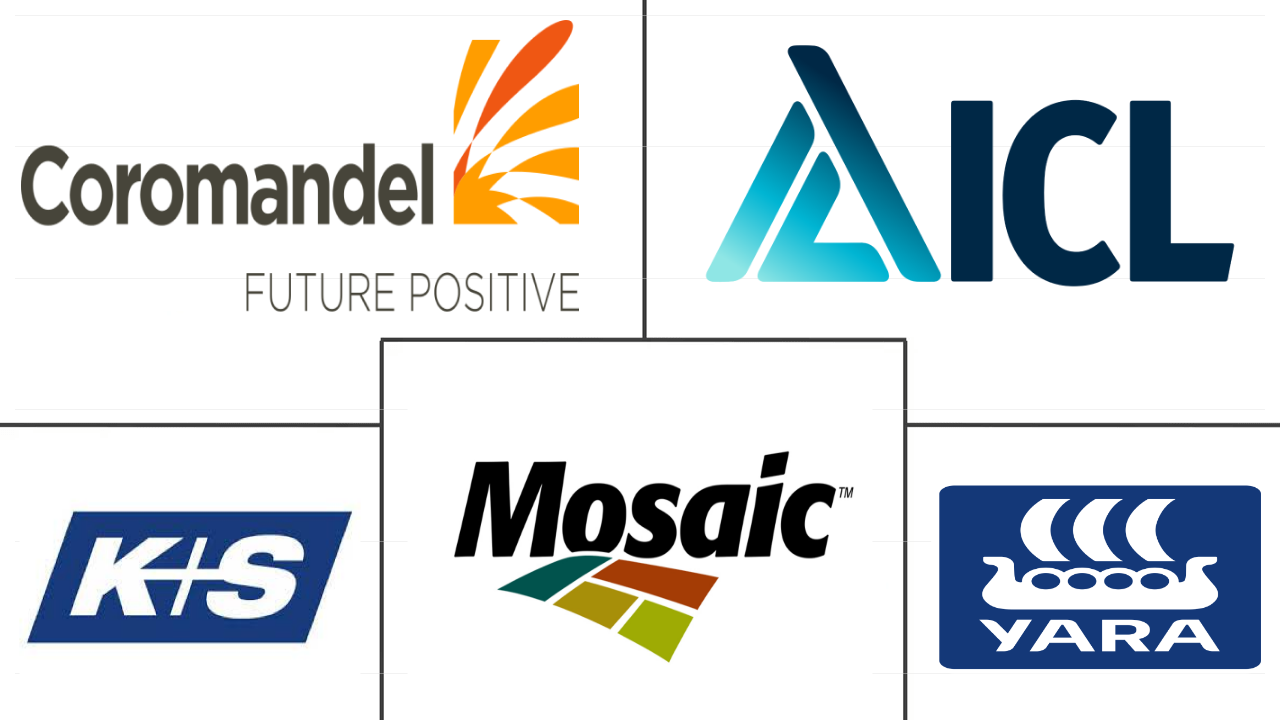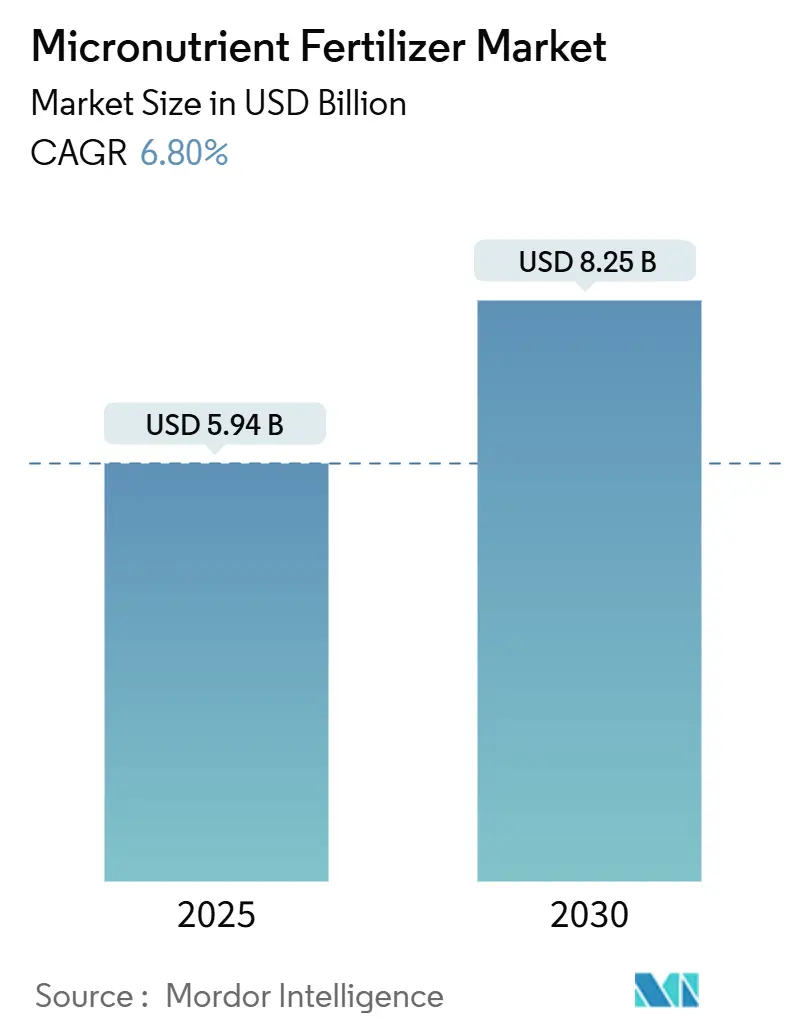
Micronutrient Fertilizer Market Analysis by Mordor Intelligence
The micronutrient fertilizer market size is estimated at USD 5.94 billion in 2025 and is projected to reach USD 8.25 billion by 2030, translating into a 6.80% CAGR over the forecast period. Soil nutrient depletion across intensive cereal belts and the shift toward high-value horticulture are the primary demand accelerators, with copper and zinc deficiencies now limiting grain yields in several wheat-rice rotations despite high NPK use. The adoption of precision application equipment, widespread subsidy programs in South and Southeast Asia, and bio-fortification mandates targeting hidden hunger are broadening the commercial opportunity spectrum for suppliers while simultaneously fostering premium segments, such as nano-chelates and controlled-release granules. On the supply side, cadmium limits under the European Union Fertilising Products Regulation 2019/1009 are driving a pivot from low-grade sulfates toward chelated variants, raising formulation costs yet widening margins for producers able to guarantee contaminant-free inputs. Headline risks center on ore price volatility, particularly for zinc and copper concentrates, and ongoing agronomic knowledge gaps in Sub-Saharan Africa that hinder adoption.
Key Report Takeaways
- By product, copper held 25.5% of the micronutrient fertilizer market share in 2024, while boron is projected to grow at a 7.5% CAGR through 2030.
- By application mode, soil application accounted for 88.3% of the micronutrient fertilizer market size in 2024, whereas fertigation is projected to advance at a 6.9% CAGR through 2030.
- By crop type, field crops led with 84.3% of the micronutrient fertilizer market share in 2024, and horticultural crops are expanding at a 7.4% CAGR through 2030.
- By geography, the Asia-Pacific region contributed 33% of the global volume in 2024; the Middle East and Africa segment is the fastest-growing, with a 7.3% CAGR through 2030.
Global Micronutrient Fertilizer Market Trends and Insights
Drivers Impact Analysis
| Driver | (~) % Impact on CAGR Forecast | Geographic Relevance | Impact Timeline |
|---|---|---|---|
| Widespread soil micronutrient deficiencies in intensive cereal belts | + 1.8% | Indo-Gangetic Plain, North China Plain, Brazilian Cerrado | Long term (≥ 4 years) |
| Rapid adoption of precision-application equipment | + 1.5% | North America, Europe, Asia-Pacific | Medium term (2-4 years) |
| Expansion of high-value horticulture under protected cultivation | + 1.2% | Spain-Netherlands corridor, Middle East and Africa, Asia-Pacific | Medium term (2-4 years) |
| Government micronutrient subsidy programs in South and Southeast Asia | + 1.0% | India, Bangladesh, Indonesia, Pakistan, Nigeria pilot | Short term (≤ 2 years) |
| Bio-fortification initiatives against hidden hunger | + 0.8% | India, Philippines, Ethiopia, Kenya, Brazil | Long term (≥ 4 years) |
| Nanochelated formulations offering higher uptake efficiency | + 0.5% | Early adopters in North America, Europe, Asia-Pacific | Long term (≥ 4 years) |
| Source: Mordor Intelligence | |||
Widespread Soil Micronutrient Deficiencies in Intensive Cereal Belts
India’s 2024 soil health card audit revealed zinc deficiency in 49% of districts, a seven percentage point increase since 2019, while boron shortfalls affected one-third of sampled plots [1]Indian Council of Agricultural Research, “Soil Health Card Database 2024,” icar.org.in. Wheat yields in China’s Henan province stagnated at 5.8 metric tons per ha from 2020 to 2024, even as nitrogen use climbed 12% because trace-element co-factors remained limiting. Indonesia’s Ministry of Agriculture distributed 120,000 metric tons of zinc-fortified NPK in 2024, boosting paddy yields by 8% in pilot plots. The underlying driver is the ongoing decline in organic matter, which reduces natural chelation and ensures structural demand.
Rapid Adoption of Precision-Application Equipment
GPS-enabled applicators reduced zinc sulfate use by 22% per hectare across 340 European farms in 2024, while increasing leaf zinc concentrations by 15%. John Deere noted that 18% of 2024 sprayer sales included micronutrient injectors, up from 11% in 2022. Drone-guided foliar boron in Canadian canola increased seed set by 9%. These gains simultaneously lower over-application risks, an emerging environmental compliance need flagged by the Commonwealth Scientific and Industrial Research Organisation (CSIRO).
Expansion of High-Value Horticulture Under Protected Cultivation
Almería’s greenhouse area reached 31,000 hectares in 2024, consuming 4,200 metric tons of chelated iron and manganese annually, a 19% increase since 2022. Saudi Arabia installed 2,400 hectares of climate-controlled greenhouses in 2024 and now injects EDDHA-iron at a rate of 0.5 g per m³ in the nutrient solution. Mexico’s Sinaloa added 1,100 hectares of greenhouses supplying winter tomatoes to North America, relying on weekly foliar applications of zinc and boron to maintain firmness during shipping. Coco-coir and perlite substrates lack inherent trace elements, resulting in a threefold increase in per-hectare micronutrient demand compared with field soil systems.
Government Micronutrient Subsidy Programs in South and Southeast Asia
India’s Nutrient-Based Subsidy disbursed USD 420 million in 2024 to zinc and iron makers, dropping retail prices 35% and lifting volumes 28% year on year. Bangladesh supplied 18,000 metric tons of subsidized boron and zinc in 2024. Indonesia mandated zinc-fortified urea for 1.2 million rice farmers, and Pakistan’s Punjab offered interest-free micronutrient credit to 45,000 cotton growers. The programs possess political durability because they align with national nutrition objectives.
Restraints Impact Analysis
| Restraint | (~) % Impact on CAGR Forecast | Geographic Relevance | Impact Timeline |
|---|---|---|---|
| High price volatility of key mineral ores | -0.9% | Import-dependent Middle East and Africa, South America | Short term (≤ 2 years) |
| Low farmer awareness in Sub-Saharan Africa and parts of Latin America | -0.7% | Sub-Saharan belt, Andean nations | Medium term (2-4 years) |
| Antagonistic interactions in multi-nutrient blends | -0.4% | Global bulk-blend markets | Medium term (2-4 years) |
| Stricter limits on heavy-metal contaminants | -0.5% | Europe, China, selective North American states | Long term (≥ 4 years) |
| Source: Mordor Intelligence | |||
High Price Volatility of Key Mineral Ores
Zinc sulfate traded between USD 1,200 and USD 1,680 per metric ton in 2024, compressing formulator margins that average 8-12%. Copper sulfate reached USD 2,400 per metric ton in mid-2024, causing some South American soybean growers to defer foliar copper applications, which resulted in a 6% decline in regional micronutrient volumes in H1 2024. Mosaic hedged 40% of its zinc sulfate inputs to cushion volatility.
Low Farmer Awareness in Sub-Saharan Africa and Parts of Latin America
Only 18% of surveyed smallholders in Kenya, Tanzania, and Ethiopia were able to diagnose maize zinc deficiency in 2024 [2]Alliance for a Green Revolution in Africa, “Farmer Awareness Survey 2024,” agra.org. Nigeria found that 72% of rice farmers in Kano and Kaduna used only urea and NPK despite 55% soil zinc deficiency. In Peru’s Andean highlands, 65% of potato growers had never heard of boron fertilizers, even though deficiency caused 20% tuber loss. Credit gaps reinforce the knowledge deficit.
Segment Analysis
By Product: Copper Dominates, Boron Surges in Water-Scarce Zones
Copper held 25.5% of the micronutrient fertilizer market in 2024, reflecting its role in lignin synthesis and disease resistance. Wheat growers in Western Australia applied 2-3 kg/ha of copper sulfate to control root rot, achieving yields of 2.1 metric tons per ha under suboptimal rainfall conditions. Boron is forecast to grow at a rate of 7.5% annually through 2030 as oilseed and fruit acreage under drip fertigation expands in India, Turkey, and Spain. Rapeseed and sunflower farmers in Rajasthan and Gujarat applied 0.5 kg per ha of soluble boron through drip systems to mitigate flower abortion, a deficiency symptom that can reduce yields by 40%.
Polymer-coated zinc sulfate captured 12% of zinc sales in 2024, up from 7% in 2022, thanks to 60-90-day controlled release favored by United States corn farmers. Chelated EDTA and DTPA complexes are gaining market share because they remain soluble across a pH range of 4-9, a decisive edge over sulfates that precipitate above pH 7. ICL reported a 16% growth in chelate sales in 2024, driven by increased greenhouse uptake in the Netherlands and Israel.
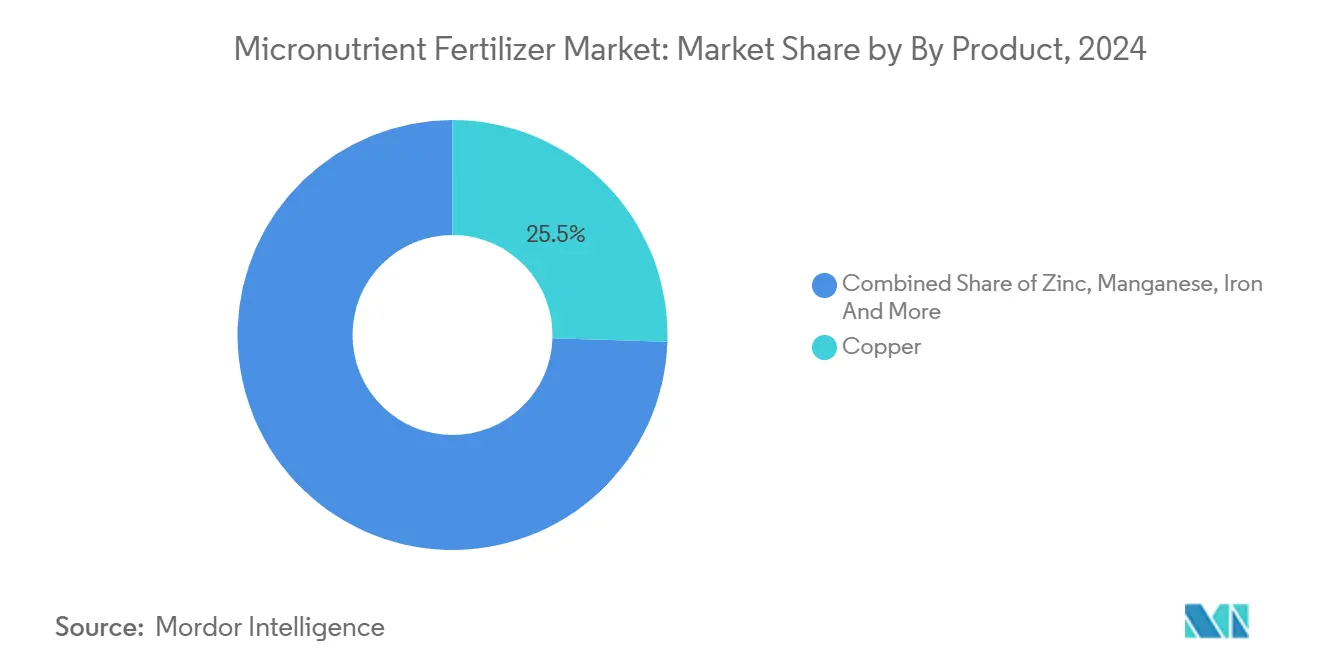
Note: Segment shares of all individual segments available upon report purchase
By Application Mode: Soil Holds Bulk, Fertigation Gains Precision Edge
Soil application accounted for 88.3% of the micronutrient fertilizer market size in 2024, driven by the adoption of low-cost broadcast granules by Brazilian soybean growers at rates of 4-6 kg per ha of zinc sulfate. Yet alkaline soils immobilize up to 70% of zinc, iron, and manganese, prompting the shift to soluble chelates.
Fertigation is climbing 6.9% annually, notably in Spain’s 31,000 ha greenhouse cluster and California’s 600,000 ha nut orchards, where drip systems deliver weekly iron and zinc injections. Foliar application, at roughly a 9% share, serves as a rapid correction: French wheat growers spray manganese at the flag leaf, adding 5-7% yield.
By Crop Type: Field Crops Anchor Volume, Horticulture Drives Value
Field crops accounted for 84.3% of micronutrient demand in 2024, as cereals continue to dominate global acreage. China’s wheat belt consumed 180,000 metric tons of zinc sulfate at 15-20 kg per ha to lift yields above 6 t/ha. Indian rice utilized 220,000 metric tons of zinc sulfate, resulting in consistent yield gains of 0.4-0.6 metric tons per ha in deficient areas.
Horticultural crops are expanding at a rate of 7.4% annually. Greenhouse tomatoes in the Netherlands, Spain, and Mexico consumed 12,000 metric tons of chelated micronutrients in 2024, with automated fertigation maintaining target tissue thresholds. Apple, citrus, and hazelnut orchards rely on annual foliar boron and iron to safeguard fruit quality.
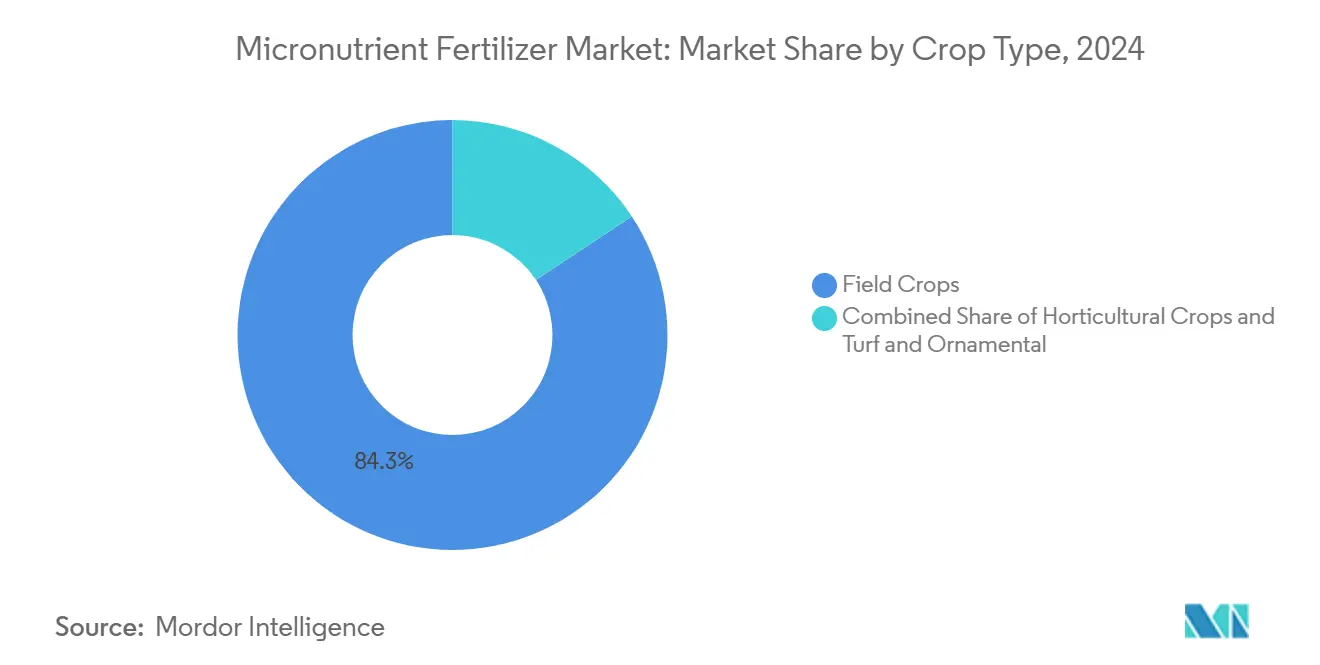
Geography Analysis
The Asia-Pacific region secured 33% of the global volume in 2024, with India, China, and Indonesia driving fertilizer demand through subsidy disbursements and labeling mandates that require the inclusion of trace elements in compound blends[3]Ministry of Agriculture and Rural Affairs, China, “GB 38400-2019 Fertilizer Labeling Standards,” moa.gov.cn. Japan’s hydroponic vegetable sector and Australia’s wheat belt make smaller yet high-value contributions.
The Middle East and Africa micronutrient fertilizer market is forecasted to grow at a 7.3% CAGR to 2030, driven by Saudi Arabia’s USD 10 billion Vision 2030 initiative and Turkey’s boron-centric hazelnut care. Nigeria’s zinc-fortified NPK pilot underscores nascent uptake, but limited extension services remain a hurdle.
North America and Europe combined account for 28-30% of the market value. Precision agriculture is mainstream, and regulatory cadmium limits accelerated a 19% jump in chelated micronutrient sales during 2024. South America, led by Brazil’s 45 million hectares of soybean expansion, adds a 6.5% annual growth impetus, with controlled-release and chelated products gaining traction in the Cerrado and Pampas regions.

Competitive Landscape
The top five suppliers, Yara International ASA, The Mosaic Company, ICL Group Ltd, K+S Aktiengesellschaft, and Coromandel International Ltd held a 57.4% collective share in 2024, signaling moderate concentration. Yara and Mosaic enjoy vertical integration from ore to blends, insulating them from raw material swings and supporting their leadership in the micronutrient fertilizer market. ICL and Coromandel focus on chelated specialties for fertigation and foliar niches, while K+S differentiates with magnesium plus micronutrient blends. Smaller Brazilian and Turkish formulators co-package micronutrients with biologicals to circumvent EU heavy-metal caps and appeal to regenerative farming practices.
Technology differentiation is sharpening competitive edges. Haifa’s nano-chelated manganese halves correction time in citrus, enabling premium pricing. Patent filings for polymer-coated micronutrients increased by 22% in 2024, led by Mosaic and Koch Agronomic Services, highlighting the industry's migration toward controlled-release technology [4]United States Patent and Trademark Office, “Polymer-Coated Micronutrient Patent Filings 2024,” uspto.gov. Regulatory compliance investments widen barriers, especially in Europe, where cadmium limits demand for purified feedstocks.
White-space opportunities persist in Sub-Saharan Africa and Andean Latin America, where micronutrient penetration remains below 15% of arable land. Suppliers that bundle agronomic advisory with tailored formulations stand to gain share as awareness programs scale.
Micronutrient Fertilizer Industry Leaders
-
Coromandel International Ltd.
-
ICL Group Ltd
-
K+S Aktiengesellschaft
-
The Mosaic Company
-
Yara International ASA
- *Disclaimer: Major Players sorted in no particular order
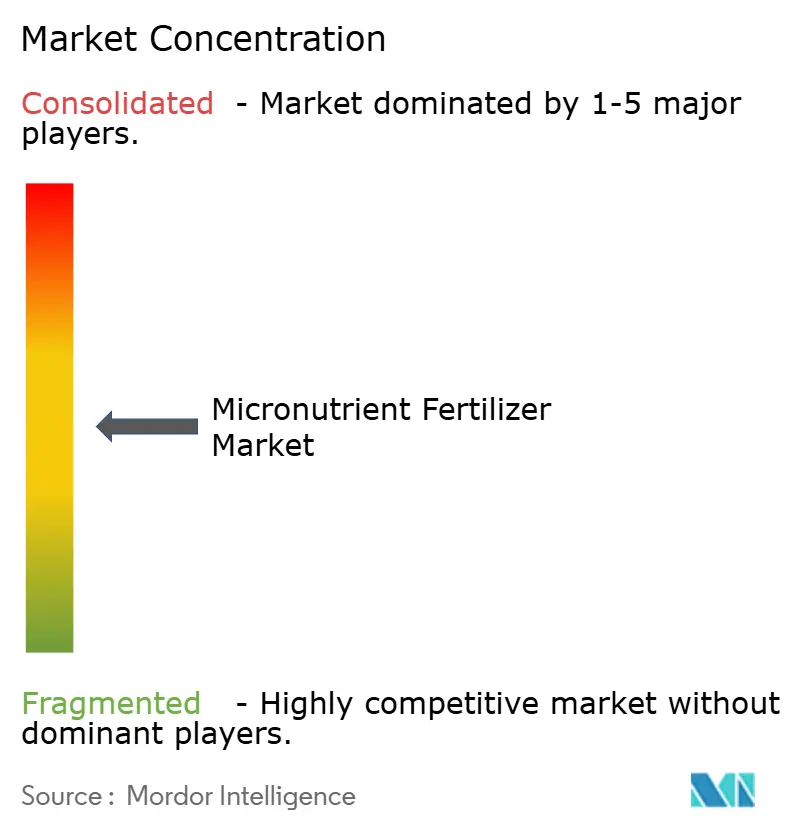
Recent Industry Developments
- August 2024: ICL’s expanded partnership with AMP strengthens its presence in China’s rapidly growing market for water-soluble specialty fertilizers, driven by rising adoption of drip irrigation and high-value crops. This agreement positions ICL to meet the evolving needs of farmers with innovative, irrigation-focused nutrient solutions.
- June 2024: Coromandel International Ltd. opened a nano fertilizer plant at Kakinada, Andhra Pradesh, expanding its capacity for next-generation fertilizers, including nano-based formulations of micronutrients such as zinc and boron. The facility strengthens the company’s ability to serve high-value horticulture and fertigation markets.
- November 2023: K+S Aktiengesellschaft is investing EUR 35 million (USD 37 million) to lift annual EPSO Micro output at its Kassel, Germany plant by 25,000 metric tons. The upgrade targets growing demand from European oilseed rape and potato farmers for magnesium-rich micronutrient blends and is slated to begin operating in the third quarter of 2025.
Global Micronutrient Fertilizer Market Report Scope
Boron, Copper, Iron, Manganese, Molybdenum, Zinc, Others are covered as segments by Product. Fertigation, Foliar, Soil are covered as segments by Application Mode. Field Crops, Horticultural Crops, Turf & Ornamental are covered as segments by Crop Type. Asia-Pacific, Europe, Middle East & Africa, North America, South America are covered as segments by Region.| Boron |
| Copper |
| Iron |
| Manganese |
| Molybdenum |
| Zinc |
| Others |
| Fertigation |
| Foliar |
| Soil |
| Field Crops |
| Horticultural Crops |
| Turf and Ornamental |
| Asia-Pacific | Australia |
| Bangladesh | |
| China | |
| India | |
| Indonesia | |
| Japan | |
| Pakistan | |
| Philippines | |
| Thailand | |
| Vietnam | |
| Rest of Asia-Pacific | |
| Europe | France |
| Germany | |
| Italy | |
| Netherlands | |
| Russia | |
| Spain | |
| Ukraine | |
| United Kingdom | |
| Rest of Europe | |
| Middle East And Africa | Nigeria |
| Saudi Arabia | |
| South Africa | |
| Turkey | |
| Rest of Middle East And Africa | |
| North America | Canada |
| Mexico | |
| United States | |
| Rest of North America | |
| South America | Argentina |
| Brazil | |
| Rest of South America |
| By Product | Boron | |
| Copper | ||
| Iron | ||
| Manganese | ||
| Molybdenum | ||
| Zinc | ||
| Others | ||
| By Application Mode | Fertigation | |
| Foliar | ||
| Soil | ||
| By Crop Type | Field Crops | |
| Horticultural Crops | ||
| Turf and Ornamental | ||
| By Geography | Asia-Pacific | Australia |
| Bangladesh | ||
| China | ||
| India | ||
| Indonesia | ||
| Japan | ||
| Pakistan | ||
| Philippines | ||
| Thailand | ||
| Vietnam | ||
| Rest of Asia-Pacific | ||
| Europe | France | |
| Germany | ||
| Italy | ||
| Netherlands | ||
| Russia | ||
| Spain | ||
| Ukraine | ||
| United Kingdom | ||
| Rest of Europe | ||
| Middle East And Africa | Nigeria | |
| Saudi Arabia | ||
| South Africa | ||
| Turkey | ||
| Rest of Middle East And Africa | ||
| North America | Canada | |
| Mexico | ||
| United States | ||
| Rest of North America | ||
| South America | Argentina | |
| Brazil | ||
| Rest of South America | ||
Market Definition
- MARKET ESTIMATION LEVEL - Market Estimations for various types of fertilizers has been done at the product-level and not at the nutrient-level.
- NUTRIENT TYPES COVERED - Micronutients: Zn, Mn, Cu, Fe, Mo, B, and Others
- AVERAGE NUTRIENT APPLICATION RATE - This refers to the average volume of nutrient consumed per hectare of farmland in each country.
- CROP TYPES COVERED - Field Crops: Cereals, Pulses, Oilseeds, and Fiber Crops Horticulture: Fruits, Vegetables, Plantation Crops and Spices, Turf Grass and Ornamentals
| Keyword | Definition |
|---|---|
| Fertilizer | Chemical substance applied to crops to ensure nutritional requirements, available in various forms such as granules, powders, liquid, water soluble, etc. |
| Specialty Fertilizer | Used for enhanced efficiency and nutrient availability applied through soil, foliar, and fertigation. Includes CRF, SRF, liquid fertilizer, and water soluble fertilizers. |
| Controlled-Release Fertilizers (CRF) | Coated with materials such as polymer, polymer-sulfur, and other materials such as resins to ensure nutrient availability to the crop for its entire life cycle. |
| Slow-Release Fertilizers (SRF) | Coated with materials such as sulfur, neem, etc., to ensure nutrient availability to the crop for a longer period. |
| Foliar Fertilizers | Consist of both liquid and water soluble fertilizers applied through foliar application. |
| Water-Soluble Fertilizers | Available in various forms including liquid, powder, etc., used in foliar and fertigation mode of fertilizer application. |
| Fertigation | Fertilizers applied through different irrigation systems such as drip irrigation, micro irrigation, sprinkler irrigation, etc. |
| Anhydrous Ammonia | Used as fertilizer, directly injected into the soil, available in gaseous liquid form. |
| Single Super Phosphate (SSP) | Phosphorus fertilizer containing only phosphorus which has lesser than or equal to 35%. |
| Triple Super Phosphate (TSP) | Phosphorus fertilizer containing only phosphorus greater than 35%. |
| Enhanced Efficiency Fertilizers | Fertilizers coated or treated with additional layers of various ingredients to make it more efficient compared to other fertilizers. |
| Conventional Fertilizer | Fertilizers applied to crops through traditional methods including broadcasting, row placement, ploughing soil placement, etc. |
| Chelated Micronutrients | Micronutrient fertilizers coated with chelating agents such as EDTA, EDDHA, DTPA, HEDTA, etc. |
| Liquid Fertilizers | Available in liquid form, majorly used for application of fertilizers to crops through foliar and fertigation. |
Research Methodology
Mordor Intelligence follows a four-step methodology in all our reports.
- Step-1: IDENTIFY KEY VARIABLES: In order to build a robust forecasting methodology, the variables and factors identified in Step-1 are tested against available historical market numbers. Through an iterative process, the variables required for market forecast are set and the model is built on the basis of these variables.
- Step-2: Build a Market Model: Market-size estimations for the forecast years are in nominal terms. Inflation is not a part of the pricing, and the average selling price (ASP) is kept constant throughout the forecast period for each country.
- Step-3: Validate and Finalize: In this important step, all market numbers, variables and analyst calls are validated through an extensive network of primary research experts from the market studied. The respondents are selected across levels and functions to generate a holistic picture of the market studied.
- Step-4: Research Outputs: Syndicated Reports, Custom Consulting Assignments, Databases & Subscription Platforms
